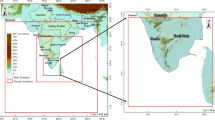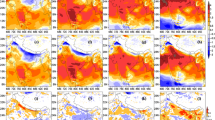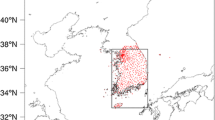Abstract
A single-model, short-range, ensemble forecasting system (Institute of Atmospheric Physics, Regional Ensemble Forecast System, IAP REFS) with 15-km grid spacing, configured with multiple initial conditions, multiple lateral boundary conditions, and multiple physics parameterizations with 11 ensemble members, was developed using the Weather and Research Forecasting Model Advanced Research modeling system for prediction of stratiform precipitation events in northern China. This is the first part of a broader research project to develop a novel cloud-seeding operational system in a probabilistic framework. The ensemble perturbations were extracted from selected members of the National Center for Environmental Prediction Global Ensemble Forecasting System (NCEP GEFS) forecasts, and an inflation factor of two was applied to compensate for the lack of spread in the GEFS forecasts over the research region. Experiments on an actual stratiform precipitation case that occurred on 5–7 June 2009 in northern China were conducted to validate the ensemble system. The IAP REFS system had reasonably good performance in predicting the observed stratiform precipitation system. The perturbation inflation enlarged the ensemble spread and alleviated the underdispersion caused by parent forecasts. Centering the extracted perturbations on higher-resolution NCEP Global Forecast System forecasts resulted in less ensemble mean root-mean-square error and better accuracy in probabilistic quantitative precipitation forecasts (PQPF). However, the perturbation inflation and recentering had less effect on near-surface-level variables compared to the mid-level variables, and its influence on PQPF resolution was limited as well.
Similar content being viewed by others
References
Anderson, J. L., 1996: A method for producing and evaluating probabilistic forecasts from ensemble model integrations. J. Climate, 9, 1518–1530.
Du, J., S. L. Mullen, and F. Sanders, 1997: Short-range ensemble forecasting of quantitative precipitation. Mon. Wea. Rev., 125, 2427–2459.
Du, J., G. DiMego, M. S. Tracton, and B. Zhou, 2003: NCEP short-range ensemble forecasting (SREF) system: Multi-IC, multi-model and multiphysics approach. Research activities in atmospheric and oceanic modelling, J. Côté, Ed., Report 33, CAS/JSC Working Group Numerical Experimentation (WGNE), WMO/TD-No. 1161, 5.09–5.10.
Epstein, E. S., 1969: Stochastic dynamic prediction1. Tellus, 21(6), 739–759.
Hamill, T. M., 2001: Interpretation of rank histograms for verifying ensemble forecasts. Mon. Wea. Rev., 129, 550–560.
Hamill, T. M., and C. Snyder, 2000: A hybrid ensemble Kalman filter-3D variational analysis scheme. Mon. Wea. Rev., 128, 2905–2919.
Hamill, T. M., S. L. Mullen, C. Snyder, Z. Toth, and D. P. Baumhefner, 2000: Ensemble forecasting in the short to medium range: Report from a workshop. Bull. Amer. Meteor. Soc., 81, 2653–2664.
Hoffman, R., and E. Kalnay, 1983: Lagged average forecasting, an alternative to Monte Carlo forecasting. Tellus A, 35, 100–118.
Hou, D., E. Kalnay, and K. K. Droegemeier, 2001: Objective verification of the SAMEX’98 ensemble forecasts. Mon. Wea. Rev., 129, 73–91.
Houtekamer, P., and H. Mitchell, 1998: Data assimilation using an ensemble Kalman filter technique. Mon. Wea. Rev., 126, 796–811.
Kong, F., K. Droegemeier, N. Levit, and N. Branch, 2006: Multi-resolution ensemble forecasts of an observed tornadic thunderstorm system, Part I: Comparison of coarse and fine-grid ensembles. Mon. Wea. Rev., 134, 807–833.
Kong, F., K. Droegemeier, and N. Hickmon, 2007a: Multiresolution ensemble forecasts of an observed tornadic thunderstorm system. Part II: Storm-scale experiments. Mon. Wea. Rev., 135, 759–782.
Kong, F., and Coauthors, 2007b: Preliminary analysis on the real-time storm-scale ensemble forecasts produced as a part of the NOAA hazardous weather testbed 2007 spring experiment. Preprints, 22th Conf. on Weather Analysis and Forecasting and 18th Conf. on Numerical Weather Prediction, Amer. Meteor. Soc., Park City, UT, 3B.2.
Kong, F., and Coauthors, 2008: Real-time storm-scale ensemble forecast 2008 Spring Experiment. 24th Conf. Several Local Storms, Savannah, GA, Amer. Meteor. Soc., Paper 12.3.
Kong, F., and Coauthors, 2009: A real-time storm-scale ensemble forecast system: 2009 Spring Experiment. 23rd Conf. Weather Analysis and Forecasting / 19th Conf. Numerical Weather Prediction, Omaha, NB, Amer. Meteor. Soc., Paper 16A.3.
Leith, C. E., 1974: Theoretical Skill of Monte Carlo Forecasts. Mon. Wea. Rev., 102, 409–418.
Lorenz, E. N., 1963: Deterministic nonperiodic flow. J. Atmos. Sci., 20, 130–141.
Molteni, F., R. Buizza, T. Palmer, and T. Petroliagis, 1996: The ECMWF ensemble prediction system: Methodology and validation. Quart. J. Roy. Meteor. Soc., 122, 73–120.
Mu, M., W. Duan, and B. Wang, 2003: Conditional nonlinear optimal perturbation and its applications. Nonlinear Processes Geophyiscs, 10, 493–502.
Mullen, S., and D. Baumhefner, 1989: The impact of initial condition uncertainty on numerical simulations of large-scale explosive cyclogenesis. Mon. Wea. Rev., 117, 2800–2821.
Mullen, S. L., J. Du, and F. Sanders, 1999: The dependence of ensemble dispersion on analysis-forecast systems: Implications to short-range ensemble forecasting of precipitation. Mon. Wea. Rev., 127, 1674–1686.
Murphy, A. H., 1973: A new vector partition of the probability score. J. Appl. Meteor., 12, 595–600.
Nutter, P., D. Stensrud, and M. Xue, 2004: Effects of coarsely resolved and temporally interpolated lateral boundary conditions on the dispersion of limitedarea ensemble forecasts. Mon. Wea. Rev., 132, 2358–2377.
Shen, Y., M. Feng, H. Zhang, and F. Gao, 2010: Interpolation methods of China daily precipitation data. J. Appl. Meteor. Sci., 21, 279–286.
Skamarock, W., J. Klemp, J. Dudhia, D. Gill, D. Barker, W. Wang, and J. Powers, 2005: A description of the Advanced Research WRF Version 2. NCAR Technical Note TN-468+STR, 88pp.
Stensrud, D. J., J.-W. Bao, and T. T. Warner, 2000: Using initial condition and model physics perturbations in short-range ensemble simulations of mesoscale Cconvective systems. Mon. Wea. Rev., 128, 2077–2107.
Swets, J. A., 1973: The relative operating characteristics in psychology. Science, 182, 990–999.
Toth, Z., and E. Kalnay, 1993: Ensemble forecasting at NMC: The generation of perturbations. Bull. Amer. Meteor. Soc., 74, 2317–2330.
Toth, Z., and E. Kalnay, 1997: Ensemble forecasting at NCEP and the breeding method. Mon. Wea. Rev., 125, 3297–3319.
Tracton, M., and E. Kalnay, 1993: Operational ensemble prediction at the National Meteorological Center: Practical aspects. Wea. Forecasting, 8, 379–398.
Walser, A., D. Lüthi, and C. Schär, 2004: Predictability of precipitation in a cloud-resolving model. Mon. Wea. Rev., 132, 560–577.
Wei, M., Z. Toth, R. Wobus, and Y. Zhu, 2008: Initial perturbations based on the ensemble transform (ET) technique in the NCEP global operational forecast system. Tellus A, 60, 62–79.
Xue, M., 2007: CAPS realtime storm-scale ensemble and high-resolution forecasts as part of the NOAA hazardous weather testbed 2007 spring experiment. 22nd Conf. Weather Analysis and Forecasting/18th Conf. Numerical Weather Prediction., Amer. Meteor. Soc., Park City, UT, Paper 3B.1.
Xue, M., 2008: CAPS realtime storm-scale ensemble and high-resolution forecasts as part of the NOAA Hazardous Weather Testbed 2008 Spring Experiment. Preprints, 24th Conf. on Severe Local Storm, Amer. Meteor. Soc., Savannah, GA, Paper 12.2.
Xue, M., 2009: CAPS realtime storm-scale ensemble and high-resolution forecasts for the NOAA Hazardous Weather Testbed 2009 Spring Experiment. 23rd Conf. Weather Analysis and Forecasting/19th Conf. Numerical Weather Prediction, Omaha, NB, Amer. Meteor. Soc., Paper 16A.
Zhu, Y., and Z. Toth, 2008: Ensemble based probabilistic forecast verification. Preprints, 19th Conf. on Probability and Statistics, New Orleans, LA, Amer. Meteor. Soc.
Author information
Authors and Affiliations
Corresponding author
Rights and permissions
About this article
Cite this article
Zhu, J., Kong, F. & Lei, H. A regional ensemble forecast system for stratiform precipitation events in northern China. Part I: A case study. Adv. Atmos. Sci. 29, 201–216 (2012). https://doi.org/10.1007/s00376-011-0137-1
Received:
Revised:
Published:
Issue Date:
DOI: https://doi.org/10.1007/s00376-011-0137-1




